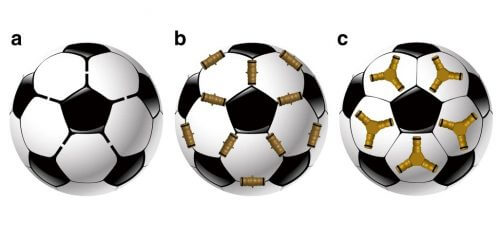Researchers at the Technion and National Taiwan University have developed hollow nanoscale spheres that may be used for safe drug delivery and vaccination

Researchers at the Technion and National Taiwan University have developed hollow nanoscale spheres that may be used for safe drug delivery and vaccination, based on chemical mimicry of natural viruses. The research, a joint work of Prof. Ehud Kinan and Dr. Efrat Solel from the Shulich Faculty of Chemistry at the Technion and their colleagues in Taiwan led by Prof. Yi-Tsu Chan, was published in the journal Nature Communication.
Spherical bodies are a common phenomenon in nature, both in the living and inanimate worlds. They are usually formed from the coalescing of 12 pentagonal tiles. Examples of such spherical symmetry are bucky spheres (molecules of carbon 60) and spherical viruses. Artificial structures, such as footballs and geodesic domes, are also constructed in a similar way.
The spherical viruses in nature apply the aforementioned symmetry to build themselves spherical shells whose outer diameter is between 15 and 500 nanometers. According to Prof. Keenan, "These shells are made up of protein subunits that come together spontaneously under the appropriate conditions and disintegrate under other conditions. This is how the viral life cycle is created. The virus shells teach us an important lesson about how artificial spherical bodies can be built."
Chemical mimicry of spherical viruses has many potential applications, such as packaging and transportation of drugs and other sensitive substances, synthesis of nanometer particles of uniform size, control of the chemical activity of various substances, chemical analysis, catalysis, architecture at the molecular level and even a safe vaccine based on synthetic antigens that mimic the viruses the originals. Similar to natural viruses, these structures are able to form and break down under controlled environmental conditions.
In 2007, part of the team of researchers proposed a general strategy for the construction of spherical shells using methods of chemical synthesis. The idea was to prepare pentagonal tiles in the laboratory that could coalesce into a ball according to different chemical mechanisms, in a manner reminiscent of assembling a football (see illustration). Although the principle seems simple, its experimental implementation encountered many difficulties and the experiments continued for more than 12 years, without success, also in other research groups.
In the end, the researchers at the Technion and Taiwan were able to realize the aforementioned strategy. They made flat bowl-like pentagonal tiles in the laboratory, connected by cations of the metal cadmium. Spontaneous coalescence of 12 pentagonal tiles and 30 cadmium ions created a spherical cage with an outer diameter of 6 nm and a shell thickness of 1 nm.
The researchers are currently designing and building balls with different chemical compositions, depending on the desired needs, for example for tasks of vaccination, controlled release of drugs, molecular architecture and utilization of solar energy.
For the full article in Nature Communications click here
